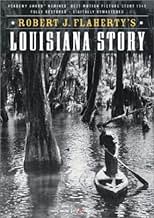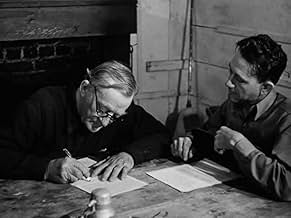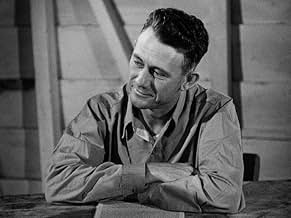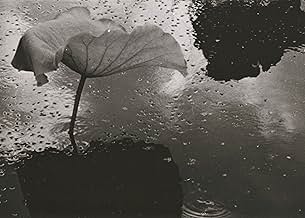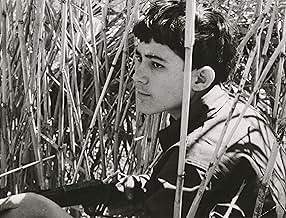CALIFICACIÓN DE IMDb
6.4/10
2.3 k
TU CALIFICACIÓN
Agrega una trama en tu idiomaThe idyllic life of a young Cajun boy and his pet raccoon is disrupted when the tranquility of the bayou is broken by an oil well drilling near his home.The idyllic life of a young Cajun boy and his pet raccoon is disrupted when the tranquility of the bayou is broken by an oil well drilling near his home.The idyllic life of a young Cajun boy and his pet raccoon is disrupted when the tranquility of the bayou is broken by an oil well drilling near his home.
- Dirección
- Guionistas
- Elenco
- Nominado a 1 premio Óscar
- 4 premios ganados y 3 nominaciones en total
- Dirección
- Guionistas
- Todo el elenco y el equipo
- Producción, taquilla y más en IMDbPro
Opiniones destacadas
This is a classic film that blurs the line between documentary and fiction. Here, you won't find a very good plot, but some very interesting sequences and some of the most visually pleasing imagery ever put to screen.
From watching both this and "Man of Aran" you can tell that Flaherty is a very unconventional filmmaker. His films have staged scenes that, as I mentioned earlier, blur the line between fiction and nonfiction creating a nontraditional signature style.
In this film, we follow a young boy (and his friend, a raccoon) living an average life in his hometown. We see him paddle down rivers, walk through the woods, and have tons of entertaining adventures. Then, a bunch of oil drillers move to town. We watch these oil drillers do their work with very minimal dialogue. It's almost all expressed in visuals.
While the film may sound boring and seems to start off kind of boring, in the end, it's a truly adventurous masterpiece! One of my favorites!
From watching both this and "Man of Aran" you can tell that Flaherty is a very unconventional filmmaker. His films have staged scenes that, as I mentioned earlier, blur the line between fiction and nonfiction creating a nontraditional signature style.
In this film, we follow a young boy (and his friend, a raccoon) living an average life in his hometown. We see him paddle down rivers, walk through the woods, and have tons of entertaining adventures. Then, a bunch of oil drillers move to town. We watch these oil drillers do their work with very minimal dialogue. It's almost all expressed in visuals.
While the film may sound boring and seems to start off kind of boring, in the end, it's a truly adventurous masterpiece! One of my favorites!
10tavm
Under the heading "Louisiana" I checked this documentary called Louisiana Story by Robert J. Flaherty out of curiosity from my local East Baton Rouge Parish Library. Beautiful views of the state swamps as well as fascinating scenes of the oil rig that inhabits them dominates the film which depicts the adventures of a Cajun boy on a boat fishing and hunting alligators with his pet raccoon. His father occasionally comes along for the ride and they both have friendly relations with the workers of the oil well. There are some scenes of the mother as well. Great Pulitzer Prize-winning music scored by Virgil Thomson is beautifully performed by The Philadelphia Symphony Orchestra as conducted by Eugene Ormandy. Wonderful cinematography by Richard Leacock. Worth checking out as a depiction of late '40s Louisiana as well as the final film of Mr. Flaherty before his death in 1951. Update-4/29/07: The Cajun boy that starred in this film, J.C. Boudreaux, is now 73 and lives with his wife of 55 years, Regina, in a FEMA trailer in the town of Sweet Lake which is south of Lake Charles. They moved there after Hurricane Rita destroyed their home in Cameron. They had seven children who have provided them numerous grand-and great-grandchildren. Boudreaux still loves fishing. I found this out reading this morning's The (Baton Rouge) Advocate.
There's not a lot to say about this film. We get random images of a Cajun boy in his canoe, paddling quietly through a bayou, looking, watching, listening ... an alligator here, a snake there, all surrounded by lush swampland vegetation.
The plot is thin. About the only thing of interest is the appearance of an oil well crew that sets up a rig near the boy's home. The crew and the boy become friends, the crew curious about the boy's ability to catch fish, and the boy curious about the new technology. Yet, from the viewpoint of the 21st century, this heavy machinery is an odious intrusion into an otherwise natural, pristine environment. And the boy and his naïve papa seem oblivious to the lurking menace of oil drilling.
The B&W photography probably is the best element of the film. "Louisiana Story" is a mostly visual film with very little dialogue. It's almost a kind of travelogue to a backwoods paradise, sans plot.
I could have wished for some Cajun songs. The music that is provided is all nondescript 1950s-style elevator music. At least the performances are not marred by well-known, professional, actors. All of the actors seem to be either local non-actors or obscure B-movie performers. The absence of Hollywood adds substantial realism to the video.
"Louisiana Story" is a look back in time to an era when people were part of their environment, not separate from it. As such, the film conveys an idyllic tone, peaceful, serene, with only the hint of the technological nightmare yet to appear.
The plot is thin. About the only thing of interest is the appearance of an oil well crew that sets up a rig near the boy's home. The crew and the boy become friends, the crew curious about the boy's ability to catch fish, and the boy curious about the new technology. Yet, from the viewpoint of the 21st century, this heavy machinery is an odious intrusion into an otherwise natural, pristine environment. And the boy and his naïve papa seem oblivious to the lurking menace of oil drilling.
The B&W photography probably is the best element of the film. "Louisiana Story" is a mostly visual film with very little dialogue. It's almost a kind of travelogue to a backwoods paradise, sans plot.
I could have wished for some Cajun songs. The music that is provided is all nondescript 1950s-style elevator music. At least the performances are not marred by well-known, professional, actors. All of the actors seem to be either local non-actors or obscure B-movie performers. The absence of Hollywood adds substantial realism to the video.
"Louisiana Story" is a look back in time to an era when people were part of their environment, not separate from it. As such, the film conveys an idyllic tone, peaceful, serene, with only the hint of the technological nightmare yet to appear.
Joseph Boudreaux is a Cajun boy living in the bayous. When a wildcat rig starts to drill near his home, he makes friends with the crew.
It's directed by pioneer documentarian Robert J. Flaherty. Flaherty for decades was considered the model documentarian. This was in large part because his NANOOK OF THE NORTH was wildly successful. Nowadays, the admiration has died down.He imposed story lines on his movies, and directed scenes to support them, as opposed to the modern ideal of shooting a tremendous amount of footage of things happening, and then editing the results to bring some sort of coherence to the resulting film. You can see his story-telling technique in the sequence where Boudreaux captures an alligator. In addition, the presence of the drillers is portrayed as completely benign, with no impact on the local wildlife. Modern understanding of global warming and the impact of oil spills and the Deepwater Horizon disaster makes this seem naive. However, Standard Oil underwrote this movie, just as NANOOK had been underwritten by furriers.
The resulting movie is a warm and idyllic one, with amusing details of Cajun superstition and the beauty of the local setting. Although not as informative as modern documentaries try to be, it's beautifully shot and well put together. Virgil Thomson won the Pulitzer Prize for best composition, the only time a movie score has achieved that distinction.
It's directed by pioneer documentarian Robert J. Flaherty. Flaherty for decades was considered the model documentarian. This was in large part because his NANOOK OF THE NORTH was wildly successful. Nowadays, the admiration has died down.He imposed story lines on his movies, and directed scenes to support them, as opposed to the modern ideal of shooting a tremendous amount of footage of things happening, and then editing the results to bring some sort of coherence to the resulting film. You can see his story-telling technique in the sequence where Boudreaux captures an alligator. In addition, the presence of the drillers is portrayed as completely benign, with no impact on the local wildlife. Modern understanding of global warming and the impact of oil spills and the Deepwater Horizon disaster makes this seem naive. However, Standard Oil underwrote this movie, just as NANOOK had been underwritten by furriers.
The resulting movie is a warm and idyllic one, with amusing details of Cajun superstition and the beauty of the local setting. Although not as informative as modern documentaries try to be, it's beautifully shot and well put together. Virgil Thomson won the Pulitzer Prize for best composition, the only time a movie score has achieved that distinction.
The opening scenes paint an idyllic picture of nature as well as the relationship it shares with people. With vegetation reflected off the surfaces of ponds, animals roaming about, and the sounds of nature in the background, the bayou feels like a slice of heaven. Even the people who occupy this land don't disrupt the environment since they appear to be one with nature. This is until we're introduced to the threat of industrialization. It starts with the boy (he's referred to as Alexander in the opening, but he's credited as "The Boy" in the film) being knocked into the water due to the wake of a motorboat. We then see an oil tower poking through some trees in the background. The interference of industrialization keeps spiraling until we're introduced to an oil well. With smog being released from its exhaust pipes and the sounds of its machinery being audible throughout much of the bayou, it seems out of place and sacrilegious.
The more one watches the film though, it becomes readily apparent that we're watching a glorification of the oil industry since the film refuses to properly acknowledge the problems it causes to the bayou. You're clearly asked to support the oil well, but given the glaring issues it causes (in addition to the real-world negative effects oil drilling has on the environment), this puts the film at odds with itself. Coming mainly from the perspectives of the working man and those impacted by the oil well, the potential for a great critique on industrialization is there, but we're instead left with an incongruity between the depiction and the endorsement of the industry. Flaherty was commissioned by Standard Oil to make the film though, so it's no surprise that it's propaganda.
The best parts of the film concern the boy's trials within the bayou. As idyllically shot as the bayou is, we're constantly reminded of the danger some of the wildlife poses, specifically in regards to an alligator which recurs throughout the film. Its scenes are memorable, with the standout being a middle scene where the boy attempts to catch it. That scene is tense, but Flaherty was undoubtedly a madman when shooting it. Boudreaux's and the alligator's scenes weren't recorded separately or anything. Rather, they were in fairly close proximity to each other, thus putting Boudreaux in actual danger when that scene was shot. As a result, the suspense in that sequence concerns worrying about real-life harm coming to the actor. To be clear, I don't approve of this as it's clearly child endangerment, but on a gut level, it made for a certain kind of thrill which left a visceral impact on me.
Overall, it's fairly interesting and I enjoyed it in some respects, but the propagandistic elements made it feel like a missed opportunity.
The more one watches the film though, it becomes readily apparent that we're watching a glorification of the oil industry since the film refuses to properly acknowledge the problems it causes to the bayou. You're clearly asked to support the oil well, but given the glaring issues it causes (in addition to the real-world negative effects oil drilling has on the environment), this puts the film at odds with itself. Coming mainly from the perspectives of the working man and those impacted by the oil well, the potential for a great critique on industrialization is there, but we're instead left with an incongruity between the depiction and the endorsement of the industry. Flaherty was commissioned by Standard Oil to make the film though, so it's no surprise that it's propaganda.
The best parts of the film concern the boy's trials within the bayou. As idyllically shot as the bayou is, we're constantly reminded of the danger some of the wildlife poses, specifically in regards to an alligator which recurs throughout the film. Its scenes are memorable, with the standout being a middle scene where the boy attempts to catch it. That scene is tense, but Flaherty was undoubtedly a madman when shooting it. Boudreaux's and the alligator's scenes weren't recorded separately or anything. Rather, they were in fairly close proximity to each other, thus putting Boudreaux in actual danger when that scene was shot. As a result, the suspense in that sequence concerns worrying about real-life harm coming to the actor. To be clear, I don't approve of this as it's clearly child endangerment, but on a gut level, it made for a certain kind of thrill which left a visceral impact on me.
Overall, it's fairly interesting and I enjoyed it in some respects, but the propagandistic elements made it feel like a missed opportunity.
¿Sabías que…?
- TriviaStandard Oil of New Jersey (became Exxon in 1972 and Exxon/Mobil in 1999) contributed $258,000 to the film's production. Although the company had no rights and no identification in the film, it stood "to get across the idea that oil companies are beneficently public-spirited, their employees honest, industrious and amiable, and their operations productive and innocuous." According to a modern source, Robert J. Flaherty's contract with Standard Oil insured that all of the film's profits went to him. The only connection was that Humble Derrick No. 1 is mentioned - and the Humble Oil Co. was 50% owned by Standard Oil of New Jersey at the time.
- ErroresIn the opening sequence, when The Boy first spots the raccoon, his hair is neat. Then it's mussed. Then it's neat again.
- ConexionesFeatured in Studies for Louisiana Story (1965)
Selecciones populares
Inicia sesión para calificar y agrega a la lista de videos para obtener recomendaciones personalizadas
- How long is Louisiana Story?Con tecnología de Alexa
Detalles
Taquilla
- Presupuesto
- USD 258,000 (estimado)
- Tiempo de ejecución1 hora 18 minutos
- Color
- Relación de aspecto
- 1.37 : 1
Contribuir a esta página
Sugiere una edición o agrega el contenido que falta

Principales brechas de datos
By what name was Louisiana Story (1948) officially released in India in English?
Responda
